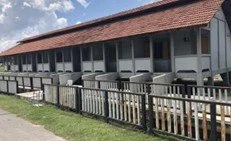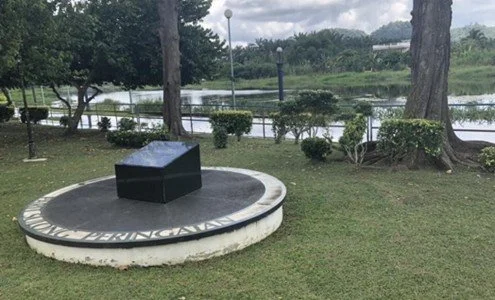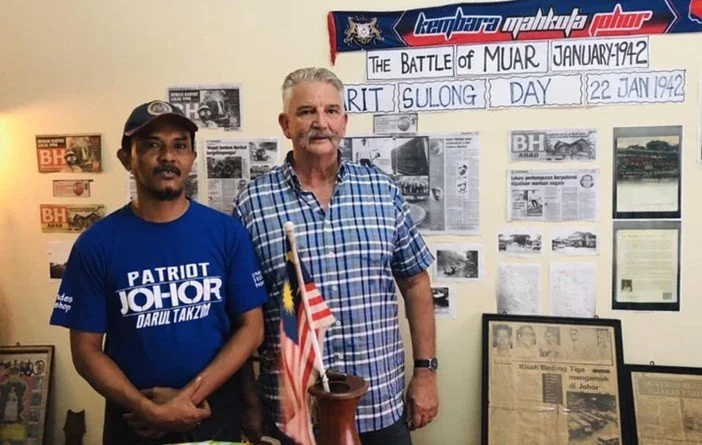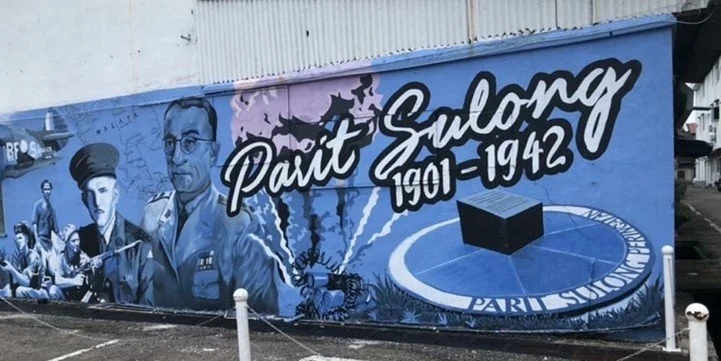PARIT SULONG MEMORIAL - Andrew Coffey
By Andrew Coffey, December 2018
My father John (Jack) Coffey was born in Fitzroy, Melbourne and was living in Malvern when the War broke out. Jack enlisted in the Army and was assigned to the 2/29th Battalion HQ Coy. Jack was a prisoner of war but returned home and lived a happy and active life reaching the age of 92. He died in 2007.
In April this year I travelled to Malaysia to follow the footsteps of my father and the 2/29th Battalion.
I travelled from Singapore with a local tour guide and also a Malay speaking interpreter. We drove into Malaysia, visiting the site of the battles of Muar and also Bakri. Our last stop of the day was at Parit Sulong.
Parit Sulong is a small town in Batu Pahat District, Johor, Malaysia on the Simpang Kiri River, 30 km east of Muar.
The historical Parit Sulong Bridge constructed during World War II is a main feature in that town. Adjacent to the bridge is an original Public Works Department building.
Public Works Building
On 22 January 1942 survivors from the battle of Muar who could not travel on foot were left at Parit Sulong.
Many of these 161 men were members of the 2/29th Battalion. The men were left with the view that they were too badly injured to travel and that the Japanese troops would hand them to the Red Cross or look after the wounded, but instead the Japanese soldiers over ran the area and massacred the 161 Australian and Allied troops. Lt Ben Hackney from the 2/29th Battalion managed to escape from his captors.
The 'maimed and bloodstained' group – as Ben Hackney described them – consisted of 110 Australian and 40 Indian troops who were left behind to be captured by the Japanese Imperial Guards Division. According to Hackney, the Japanese delighted in kicking and hitting the prisoners with rifle butts.
They forced them into an overcrowded shed and denied them food, water and medical attention. At sunset, those able to walk were roped or wired together and were led away. Hackney, who was seriously wounded, and a few others were left for dead.
The Japanese collected petrol from the Allied vehicles which had been left stranded, shot their prisoners, threw petrol upon them and ignited it.
Ben Hackney, very badly wounded, was one of just two men to escape. The Japanese captured him a few weeks later and he became a prisoner of war.
Ben Hackney wrote that the wounded men, some of whom had been carried in the road convoy for up to four days during the battle, lay helplessly either in trucks or on the ground exposed to the action with not even anything to drink ... lots of fellows mad or near mad from pain.
The officer who ordered the massacre, Lt General Takuma Nishimura, was tried and convicted of war crimes and executed by hanging on 11 June 1951.
The Public Works building were the massacre occurred has been recently restored and now stands as a monument to the atrocities which occurred there.
A memorial garden was also installed in the village adjacent to the Parit Sulong bridge, the opening of this garden was attended by some family members of the 2/29th Battalion.
My Malay speaking guide also located a small cafe in the village which has on display memorabilia from the Battle and also the massacre. The cafe is run by a local man, Kamarulbaharin, who through the interpreter told me that his Grandfather was present during the time that the 2/29th Battalion was active in the area and his grandfather supplied food and supplies to support the Allied troops.
Kamarulbaharin and Andrew
It was actually a very emotional visit, and I felt a close bond with Kamarulbaharin, he then showed us around the village and we met with a village elder. He also brought to our attention a mural on a nearby wall which was produced by the local trade school. It depicts an image of Lt Ben Hackney and also Col. Anderson.
The display which Kamarulbaharin maintains has taken him many years to build up. I am a committee member of the 2/29th Battalion Association and at our last meeting requested that the committee make a financial contribution to Kamarulbaharin to help him maintain and improve his display. The request was approved by the committee for a small initial donation to be made. It was also discussed that a plaque should also be installed in the area to acknowledge the 2/29th Battalion.
I will travel again next May to Parit Sulong to deliver the donation on behalf of the 2/29th Association and install a plaque. At this stage another couple of committee members may also be available to attend. This trip is not limited to committee only and anyone else that is interested may also attend.





